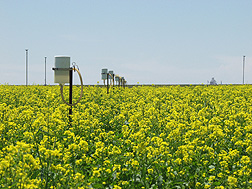Models Suggest Canola Could Be New
Biofuel Crop for the Central Great Plains
Farmers in the semiarid central Great Plains have traditionally used a 2-year, no-till, dryland, winter wheat/fallow cropping system, which stretches scarce soil water supplies and minimizes crop failure from water stress. Now they are interested in growing crops during the fallow period, using water normally lost to evaporation.
To help assess production options, Agricultural Research Service agronomist David Nielsen is developing models that calculate the probability of raising profitable crops of spring canola, which produces seed oil that can be used to produce biodiesel. Nielsen works at the ARS Central Great Plains Research Station in Akron, Colorado.
Nielsen partnered with soil scientist Liwang Ma, research leader Laj Ahuja, and crop scientist Saseendran Anapalli, who all work at the ARS Agricultural Research Systems Unit in Fort Collins, Colorado. They began by adapting the CROPGRO computer model, which simulates plant growth processes under different weather, soil, and crop management conditions, to simulate spring canola production.
The team then added this CROPGRO canola cropping systems model to the Root Zone Water Quality Model 2 (RZWQM2), which was developed at Fort Collins. RZWQM2 simulates the effects of management on plant growth and the movement of water, nutrients, and chemicals within and around crop root zones. The researchers ran the combined model with 16 years of regional weather data, four different soil water levels at planting time, and other site-specific information to generate spring canola yield estimates for nine locations in Nebraska, Colorado, and Kansas.
The team found the simulated yields were consistent with regional precipitation and temperature patterns, factors that led to the highest average yields in the north-central area near Champion, Nebraska, and the lowest in the south-central area near Walsh, Colorado. When 75 percent of the soil water was available for crop use at planting, the model indicated that six of the sites had more than a 70-percent probability of producing a canola seed yield of at least 900 pounds per acre.
Using the average simulated yields at each location, the researchers ran an economic analysis that projected net returns. This analysis indicated that the most profitable location for canola production was Champion, with average net returns ranging from $67 to $189 per acre, depending on plant-available soil water levels. Simulations produced positive average net returns for five sites—Champion, Nebraska; Garden City, Kansas; McCook, Nebraska; Sidney, Nebraska; and Tribune, Kansas—even when only 25 percent of the soil water was available for crop use at planting.
Nielsen used these simulation results with Microsoft Excel to develop a simple decision-support tool for canola production and economic analysis.
“We need to carry out field studies,” says Nielsen. “But farmers could use this decision-support tool to calculate the probability of producing the minimum spring canola yield they need to turn a profit—or they could use the seed oil they produce for their on-farm biodiesel production to run tractors and other equipment.”—By Ann Perry, Agricultural Research Service Information Staff.
This research is part of Agricultural System Competitiveness and Sustainability, an ARS national program (#216) described at www.nps.ars.usda.gov.
To reach the scientists mentioned in this article, contact Ann Perry, USDA-ARS Information Staff, 5601 Sunnyside Ave., Beltsville, MD 20705-5128; (301) 504-1628.
"Models Suggest Canola Could Be New Biofuel Crop for the Central Great Plains" was published in the October 2013 issue of Agricultural Research magazine.







